By March, the Common Cranes Grus grus have returned to Niedersachsen, Germany, and their distant unison calls radiate bright harmonic spectra through the dim forest. On a small, exposed ridge in a clearing, a tiny owl perches boldly on top of a small European Hornbeam Carpinus betulus. His movements are quick and nervous. The hawks have gone to roost but the larger owls are yet to emerge. For a short period after sunset, the Eurasian Pygmy Owl Glaucidium passerinum is raptor in chief.
Every two seconds he advertises for a mate. His tail twitches slightly with each soft-edged beep, high-pitched for an owl but low considering his size. Recording a mobile pygmy owl in ambient stereo is a challenge. In the course of 15 minutes he changes perch often, broadcasting in all directions and frustrating my attempts to sneak a microphone underneath him. Now a gust has just passed and there is a gap between planes. In a few minutes the first Tawny Owl Strix aluco will call. He grants me one last chance, and then falls silent until dawn (CD2-01).
CD2-01: Eurasian Pygmy Owl Glaucidium passerinum Lüneburger Heide, Niedersachsen, Germany, 17:50, 6 March 2008. Hooting of an unpaired male. Background: Common Blackbird Turdus merula. 080306.MR.175046.01
In CD2-02, a neighbour of the first male, wound up by a whistled imitation from us, replies with ‘excited hooting’. In this variant he inserts du notes between the usual hoots. At first, several of these combine into a short trill. Then the number of du notes gradually decreases until the series ends without them. If you imitate a pygmy owl or use playback, excited hooting is very likely to be the response. Paired males like this one also sometimes reply to their mate with excited hooting. Much less often, a bachelor may produce it on hearing a rival in the distance, or when a female ventures onto his territory (Scherzinger 1970).
CD2-02: Eurasian Pygmy Owl Glaucidium passerinum Lüneburger Heide, Niedersachsen, Germany, 20:58, 30 April 2008. Excited hooting of a paired male. Background: Eurasian Woodcock Scolopax rusticola, Common Blackbird Turdus merula and European Robin Erithacus rubecula. 080430.MR.205804.12
Håkan has been attacked several times after whistling a Eurasian Pygmy Owl, most recently when I was with him in March 2014. Seeing so small a creature hitting him on the head with its talons made me laugh. For a Star Wars fan, it would be like Yoda taking on Count Dooku. Anyway, judging from his exclamation, it really hurt! More than once, an owl has continued to attack him even when he was walking away like a good boy. His nastiest experience started once when he was trying to find out if some perfect-looking habitat was occupied. There was no response to his whistling, but suddenly he received a hard slap on the forehead. Only after this did the owl hoot from close range. Usually it is other owls and carnivorous mammals that bear the brunt of pygmy owl attacks. When one pygmy attacked a Ural Owl Strix uralensis in May, it gave a quick, sharp and very shrill chitter call as it dived at the owl’s back.
Eurasian Pygmy Owls have good reason to be wary of other owls. Mikkola (1983) found 11 individuals in the prey remains of five other owl species. Even predation by Tengmalm’s Owl Aegolius funereus has been recorded four times (Korpimäki & Hakkarainen 2012). When Dave McAdams discovered his first pygmy owl in the forest where this chapter began, it was calling from the top of a conifer at dusk. Dave started to use a ‘Hazel Hen’ whistle to imitate some female or juvenile calls. It reacted immediately, flying down and straight at him, skimming over his head by a fraction and giving him quite a fright. The pygmy owl remained very close and then, surprisingly, a Tengmalm’s Owl appeared and flew at it. Dave could hear excited calls from one or both owls. The Tengmalm’s remained perched nearby for a few seconds (it was only then he identified it), before noticing him and flying off.
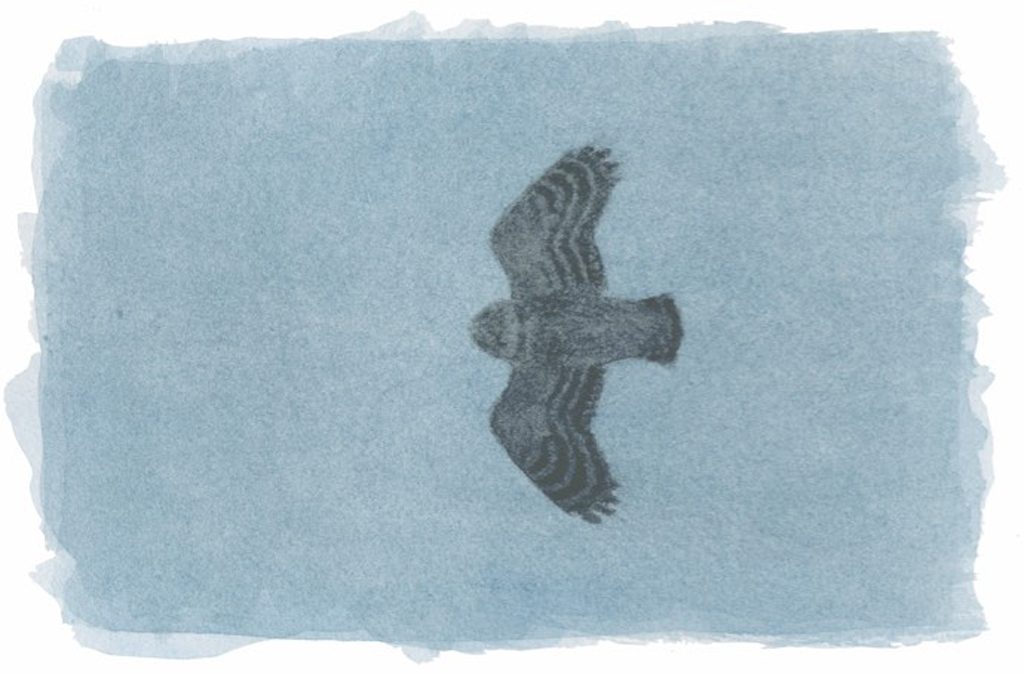
Håkan Delin
There is no Palearctic owl smaller than a Eurasian Pygmy Owl, but if there was it would surely feature on Pygmy’s menu. As the mobbing in CD2-03 suggests, small birds form an important part of its diet, especially during periods when birds are more easily available than rodents. Small forest birds in winter travel in easily heard flocks. In the harshest conditions they need all their time to find food, which means cutting down on vigilance. Pygmy owls roam along the fringes of flocks, staying in the tree crowns in order to ambush from above. The birds caught most easily are those small, peripheral species like Goldcrest Regulus regulus and Coal Tit Periparus ater that are less able to compete with larger species like Crested Tits Lophophanes cristatus and Willow Tits Poecile montanus for the safer central parts of the trees (Kullberg 1995).
CD2-03: Eurasian Pygmy Owl Glaucidium passerinum Ysen Lake, Hälsingland, Sweden, 06:06, 26 March 2014. Coal Tits Periparus ater, Common Chaffinches Fringilla coelebs and a Eurasian Siskin Spinus spinus mobbing a hooting male. Background: Northern Raven Corvus corax. 140326.MR.060606.00
Among the more surprising birds that Eurasian Pygmy Owls catch are aquatic species like Black-bellied Dipper Cinclus cinclus (Voous 1988) and large ones like Mistle Thrush Turdus viscivorus, twice the weight of the owl (Cramp 1985). In summer, they even catch Common Swifts Apus apus (Kellomäki 1977), presumably by entering their nesting cavities in mature forest. Such a prolific bird hunter is bound to catch the odd rarity from time to time. On 27 October 2005, a first-winter female Siberian Rubythroat Calliope calliope was found freshly dead in a pygmy owl nestbox at Kokkola (van den Berg & Haas 2005). It was only the third for Finland.
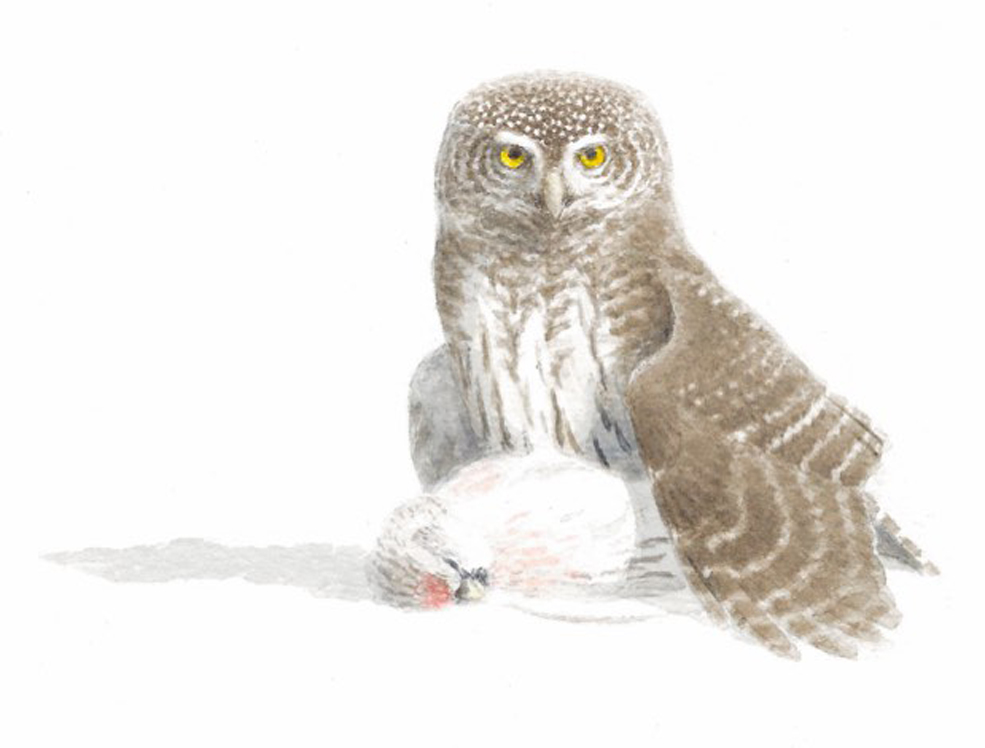
Håkan Delin
Not every hunt is successful, and Eurasian Pygmy Owls of both sexes may express internal conflict with a special kind of song called frustration hooting (‘Konfliktgesang’). In females it is probably their only kind of hooting. Frustrated hooting includes du notes, but differs from excited hooting in having a ‘wobbly’ pitch. Internal conflicts of various kinds can trigger it. In CD2-04, a female gives two short series of frustration hooting in response to Dave’s imitation of a male (not included). Approaching the source, she expects to meet her mate for the first time that evening. Instead, she finds herself facing us birders. The three very high-pitched soliciting calls in the middle of the recording are presumably attempts to call her mate.
CD2-04: Eurasian Pygmy Owl Glaucidium passerinum Lüneburger Heide, Niedersachsen, Germany, 17:56, 7 March 2008. Frustration hooting and soliciting calls. Background: Song Thrush Turdus philomelos, Common Blackbird T merula and Goldcrest Regulus regulus. 080307.MR.175649.32
For most of the year, the soliciting call is in fact the female’s most characteristic sound, to such an extent that Scherzinger (1970) called it the ‘female-specific call’. She uses it to indicate where she is, and as a begging call towards her mate. She even uses it in various situations when she is alone (Scherzinger 1970). Soliciting calls can be long or short, rising in pitch or level, but all variants have in common that they reach an extremely high pitch for an owl.
During the breeding season and for much of the year, hooting and soliciting calls are the basic clues for us to identify male and female, respectively. Most interactions start with these two sounds and their variants. Food exchanges, nest selection and copulation all subsequently require close proximity of the pair, and several short-range sounds then help these highly aggressive owls to overcome their mutual intolerance.
CD2-05 illustrates a sequence of calls accompanying copulation. The male announces himself with a single hoot while the female produces a series of soliciting calls. Flying in to join her, the male gives a series of low trills. As he mounts the female, we hear several piercing shrieks. Based on sonagrams, these come from the male (contra Scherzinger 1970). Immediately afterwards he departs to a safe distance with a series of rising whistles. He is smaller than the female, and rarely stays close to her for long.
CD2-05: Eurasian Pygmy Owl Glaucidium passerinum Hauho, Kanta-Häme, Finland, 31 March 2002. Soliciting calls of female, hoot and low trills of male. Copulation call at 0:19. Background: Common Blackbird Turdus merula, Great Tit Parus major and Northern Bullfinch Pyrrhula pyrrhula pyrrhula. 02.003.KM.01045.11
During food passes the sequence of calls is very similar, especially for the male. First he announces his presence and his mate answers. Then he uses one type of call to approach and another to depart. CD2-06 starts with the male hooting not far from a nestbox and the female replying with soliciting calls. The nestlings also hear the male and one of them chirps quietly. The female moves to the nestbox entrance and begs impatiently with her soliciting call. Using a series of trills, the male indicates that he is ready to hand over the prey. The female flies out to join him. When she arrives, the male interrupts a trill to give a shrill chitter call. He flies away as soon as he can, giving a series of departure whistles, very similar to the whistles when departing after copulation. These are higher-pitched than hooting, and usually begin with a rising intonation. The female continues to solicit and soon flies off after the male. A nestling chitters discontentedly in the nest. Perhaps the female scared the male away before he was able to hand over the prey.
CD2-06: Eurasian Pygmy Owl Glaucidium passerinum Porras, Kanta-Häme, Finland, 22:00, 10 June 2009. A food pass, with hooting and trills of male, soliciting calls of female and chittering of nestlings. One of the adults also chitters at the moment of transfer. The male departs with rising whistles. Background: Eurasian Bittern Botaurus stellaris, Eurasian Woodcock Scolopax rusticola and European Robin Erithacus rubecula. 090610. DF.220000.01
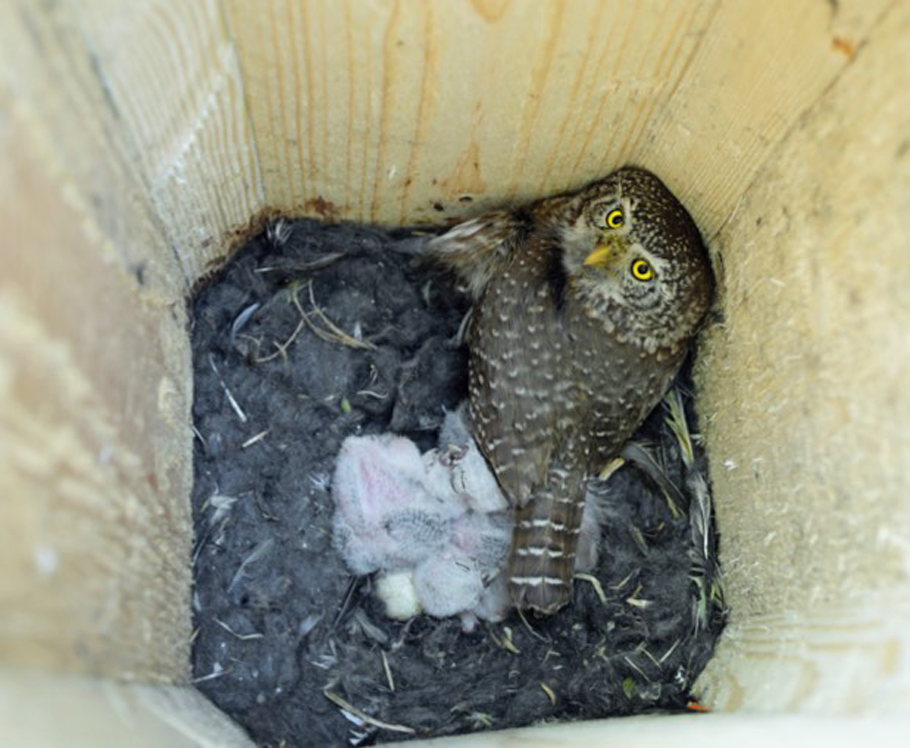
Eurasian Pygmy Owl Glaucidium passerinum, with chicks, Hauho, Kanta-Häme, Finland, 24 May 2009 (Dick Forsman). Same as in CD2-06 but two weeks earlier.
CD2-07 is a more successful food pass at the same nest, recorded 18 days earlier. As usual it starts with a male-female
duet. The male’s last hoots turn into two-part ‘beckoning calls’, and then he trills while handing over the prey. His departure is marked by two single, rising whistles. This time the female returns to the nestbox where she divides the food while giving short bursts of feeding calls.
CD2-07: Eurasian Pygmy Owl Glaucidium passerinum Porras, Kanta-Häme, Finland, 21:47, 23 May 2009. Food pass at same nest as in CD2-06, 18 days earlier. Hooting of male, soliciting call of female and faint calls of young. Beckoning calls at 0:32-36, then trills of male followed by two departure calls. Feeding calls of female from 1:09. Background: Eurasian Woodcock Scolopax rusticola, Great Spotted Woodpecker Dendrocopos major and European Robin Erithacus rubecula. 090523. DF.214700.11
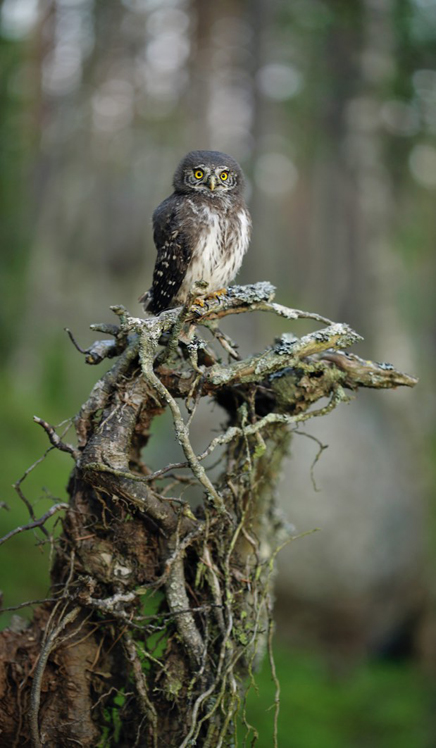
Eurasian Pygmy Owl Glaucidium passerinum, juvenile, Luopioinen, Pirkanmaa, Finland, 10 June 2009 (Dick Forsman)
Begging calls of juvenile Eurasian Pygmy Owls start as weak and very short squeaks but evolve into a sound similar to the soliciting call of the female. After the young leave the nest, these calls help them to stay together and allow the adults to find them. The brood in CD2-08 was still about a week from fledging. Besides their begging calls, there are several very quiet gyu calls of the adult female, an excitement call often heard when the young are in danger. Sometimes gyu calls can be heard as the first sign of activity in the morning or as the last call given when flying to the roost at night. At higher levels of excitement they may be strung into a series as in CD2-09, recorded at a nest in Finland.
CD2-08: Eurasian Pygmy Owl Glaucidium passerinum Hattula, Hauho, Kanta-Häme, Finland, 16:36, 10 June 2009. Begging calls and chitters of nestlings with gyu calls of adult female. Background: Common Chaffinch Fringilla coelebs and European Robin Erithacus rubecula. 090610.DF.163600.01
CD2-09: Eurasian Pygmy Owl Glaucidium passerinum Porras, Hauho, Kanta-Häme, Finland, 21:47, 23 May 2009. Gyu calls in a series. Background: Song Thrush Turdus philomelos. 090523.DF.214700.31
Adult Eurasian Pygmy Owls are among the more sedentary of Western Palearctic owls. If necessary, a pair will move from a summer territory with better nest holes, sometimes in deciduous forest, to a winter territory nearby with better cover, usually offered by Norway Spruce Picea abies. A few adult females do change location from one breeding season to the next (Wiesner 1992), but most pairs are able to stay within a very limited area all year round. Occasionally, mass movements occur in Scandinavia and the Baltic countries in years when the vole population crashes, but these mostly involve juvenile females (Polakowski et al 2008).
Eurasian Pygmy Owl has never been recorded in Britain, not even as Pleistocene remains. Finding the first will of course be largely a matter of luck, but knowing its autumn sounds may help. Antero Lindholm (in litt) reports that pygmies are the most vocal of several owl species that pass through the south-western corner of Finland in autumn. Their commonest autumn call is the ‘scale’ (König 1968, Scherzinger 1970), which they also sometimes use in spring. In early March, the German pair from the start of the chapter ‘scaled’ quite often but usually just once, which made recording the sound very difficult. So I went to Poland in autumn.
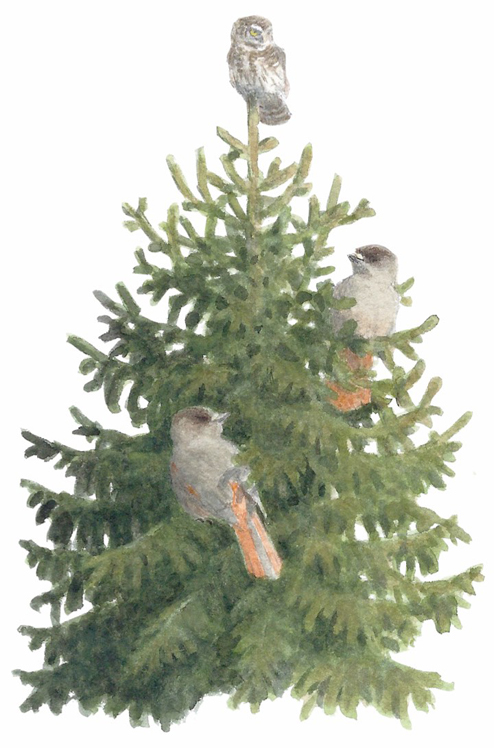
Håkan Delin
Białowieża forest has a healthy population of Eurasian Pygmy Owls, and 2012 had been a particularly good breeding season. On my first day, I arrived long after sunset. For the rest of that evening, the pygmy owls were silent, but Tengmalm’s Owls and Tawny Owls called from time to time. Finally, at quarter to one in the morning, a single very loud scale shattered the silence like a fanfare, possibly in reaction to some distant tsyuck calls of Tengmalm’s. In CD2-10, after two introductory whistles that descend in pitch, the notes of the ‘scale’ gradually rise and accelerate to a climax that resonates for several seconds through the forest.
CD2-10: Eurasian Pygmy Owl Glaucidium passerinum Białowieża forest, Podłaskie, Poland, 00:46, 3 October 2012. Scale at close range in autumn. Background: Tengmalm’s Owl Aegolius funereus and European Robin Erithacus rubecula. 121003.MR.004626.01
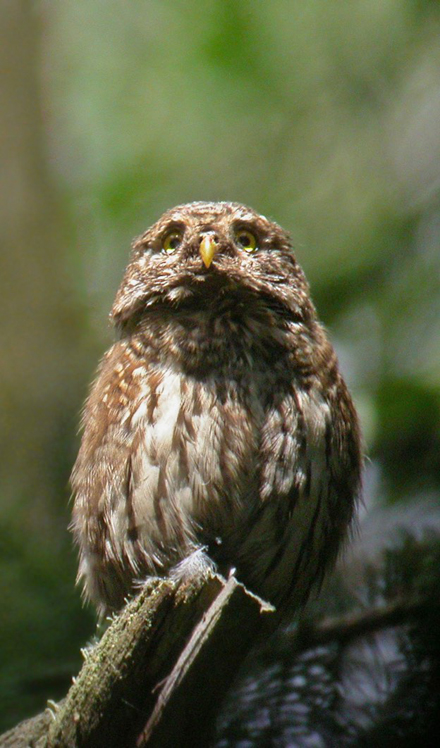
Eurasian Pygmy Owl Glaucidium passerinum, Białowieża forest, Podłaskie, Poland, 16 June 2005 (Magnus Robb)
It was only towards the end of the night that scales began to ring out more regularly. There was an obvious peak around one hour before sunrise, when they came from all directions, two or three individuals per minute. Sometimes a wave of them would approach then recede as neighbour responded to neighbour across several kilometres of suitable habitat. In CD2-11 there are three. The first and last calls are much more similar to each other than either is to the second, so probably both came from the same individual. Some chitter calls precede the first scale, perhaps betraying fear of the Northern Goshawk Accipiter gentilis already awake in the distance. After the last call in the recording, the pygmy owls fall silent till dusk.
CD2-11: Eurasian Pygmy Owl Glaucidium passerinum Białowieża forest, Podłaskie, Poland, 06:14, 8 October 2012. Scale calls, the closest pass of a ‘Mexican wave’ crossing the forest. Background: Northern Goshawk Accipiter gentilis, Eurasian Skylark Alauda arvensis, Dunnock Prunella modularis, Common Blackbird Turdus merula, Eurasian Jay Garrulus glandarius, Common Chaffinch Fringilla coelebs and Common Reed Bunting Emberiza schoeniclus. 121008.MR.061419.02
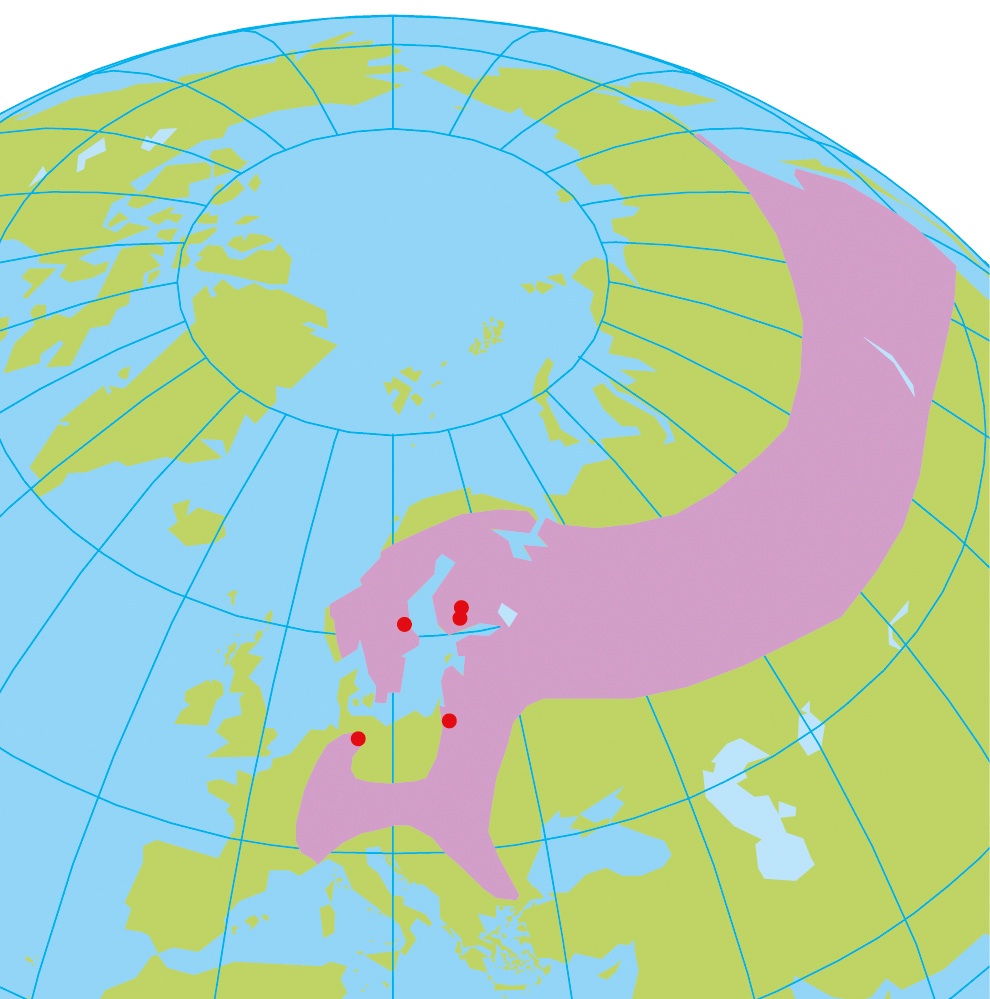
Approximate breeding distribution of Eurasian Pygmy Owl Glaucidium passerinum . Recording locations indicated by red dots.
The only other owl in the Western Palearctic with hooting similar to Eurasian Pygmy Owl is the slightly larger Eurasian Scops Owl Otus scops. The genuses they belong to could hardly be more different. Pygmy owls are smaller, yet they tend to go for larger prey. Scops Owls are far more intrepid travelers. With our recognition of Cyprus Scops Owl O cyprius and the recent addition of Rinjani Scops Owl
O jolandae (Sangster et al 2013), Otus has 50 species, most of which are tropical and 34 of which are endemic to islands. Some of these islands are far out in the ocean. Glaucidium has 25 species, again mostly tropical, only one of which – Cuban Pygmy Owl G siju – is endemic to an island (Mikkola 2012). Cuba is less than 200 km from the nearest mainland.
The English Channel is only 34 km wide but Eurasian Pygmy Owl, now breeding as close as Belgium (Sorbi 2013), has never crossed it. As for the warmth-loving Eurasian Scops Owl, the top UK destination for vagrants is the windswept, treeless Shetland Islands, an overshoot of 1500 km or more.
